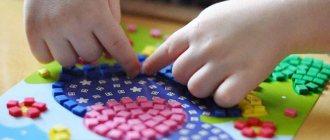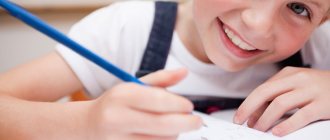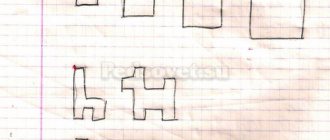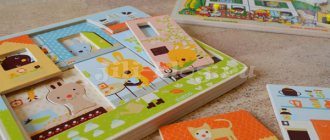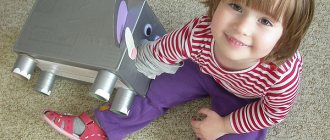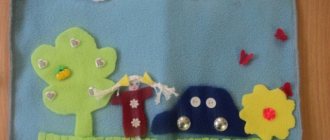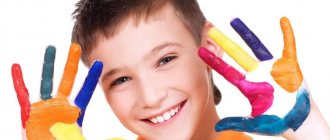Child psychologists have proven that the brain is directly related to a child’s ability to use his hands and fingers and perform various actions with them. That's why parents need to play games with their children to gradually develop fine motor skills. Training should be carried out regularly, be varied and not tire the child.
Definition
Fine motor skills are a set of movements performed by the fingers and hands. It is extremely important to develop it for several reasons.
- Through such activities, the internal organs of the baby are affected. Exercise has a beneficial effect on brain development.
- The ability to perform movements with fingers and hands is most often an indicator that the child is fully developing.
- Finger movements are directly related to speech centers in the cerebral cortex, so experts recommend training your hands in parallel with speech development. Moreover, doing motor skills exercises will help those children who suffer from speech impediments begin to speak better.
Work on fine motor skills should begin from a very early age. Even babies have their fingers massaged, but older children need to learn to perform basic actions on their own. This will be helped by special play exercises that are interesting and useful for kids.
Benefits of exercise
Games and exercises that develop fine motor skills should be carried out with the child on a regular basis, as they not only improve the baby’s ability to work with his fingers and hand, but also stimulate speech development.
Without such activities, there is a risk that the child will be unprepared for school, his hand will not be able to hold a pen or write correctly. And the child himself may find himself helpless and experience difficulties in performing such basic actions as tying shoelaces.
Daily exercise will help improve attention and memory. Gaming technologies are diverse, so any parent can choose exercises to their liking.
Age
Pediatricians recommend starting conscious daily training with a child who is 4-5 years old. But at an earlier age, fingers need to be given attention - massage, kneading active points that are directly connected to the brain centers.
So, for the youngest (up to 2 years old) the following exercises can be used:
- stroking the palm;
- flexion-extension of fingers;
- clapping your hands.
To make the child have fun, the lesson should be accompanied by reading nursery rhymes about the White-sided Magpie and playing “Ladushki”.
If a child attends kindergarten, then teachers in the younger group conduct classes on the development of fine motor skills, but for parents this is not a reason to refuse home training, which will help consolidate the acquired skills and translate them into skills. Therefore, on weekends you need to work with your baby using a playful form, offering him new interesting tasks.
Hatching tasks
This type of activity is suitable for more diligent children, but at the same time, shading is very useful for the development of hand muscles. You need to start classes with simpler exercises: for example, prepare cards with images of animals, on which a few strokes will already be drawn as an example. The child is asked to complete the shading at the same angle and with the same distance between strokes. More advanced level - arbitrary shading. For example, a child may shade two identical images differently depending on the story they come up with.
Rules for performing finger exercises
Working with the baby on the development of fine motor skills should be carried out on a regular basis, but not tire the child. The easiest way to do it is with finger games, which perfectly stimulate the brain and help develop dexterity, attention, and memory. The work is carried out first with the right hand, then with the left. An adult is required to monitor the correct execution of the movements, so before showing them to a child, you need to practice yourself.
Advice
You should start with 2-3 repetitions of each exercise, gradually increasing them to 5-8. Training is carried out daily, and a few minutes a day is enough.
Didactic manuals advise: if the child gets tired, the lesson can be broken up. Do the first two exercises in the morning, two more in the afternoon, and one in the late afternoon.
Most popular games
The game catalog contains a huge number of options. We offer some simple finger games that are loved by most children.
- Squeeze all the fingers on both hands, then unclench them. Run several times.
- Squeeze the fingers on your right hand and unclench them one by one. Repeat the exercise with the left.
To make it interesting for the child, during the lesson the parent can read funny poems to him or write a story about how a fairy-tale character (a bear) got home with the help of finger movements. For example: the bear passed the first forest - extend one finger. The bear passed the second forest - we unbend the second one. The child will try to do the exercise to find out how the fairy tale ends.
- "Fan". The exercise is useful for the fingers; it is performed like this: press your fingers together (imitating a closed fan), then spread them as wide as possible (the fan has opened), and wave your hand.
- A very good exercise that helps develop not only motor skills, but also attention and reaction speed - “Scratch-scratch”. The parent places his hand on the table, the baby places his palm on the adult’s palm and listens to him. Mom or dad tells a poem or a fairy tale, the child’s task is to be attentive. As soon as “tsap-scratch” is heard (this can be any other phrase discussed in advance), he needs to remove his palm as quickly as possible, otherwise the parent will cover it with his other hand. After a few practices, parent and baby can switch roles.
- "Butterfly". First, the fingers are clenched into a fist, now you need to straighten the little finger one at a time, then the ring and middle fingers. Create a ring from the index finger and thumb. The butterfly is ready. Now you need to ask the child to “flap his wings” - make movements with straight fingers.
If one of the finger games causes difficulty, you can replace it with another for a while; you should not torment your child with a mandatory mindset for success.
Development of fine motor skills of the hands. Games and exercisesmaterial on the topic
Development of fine motor skills of the hands. Games and exercises.
Fine motor skills are the ability of a person to make small and precise movements of the hands and fingers and toes as a result of the coordinated actions of three systems: nervous, muscular and skeletal. The development of fine motor skills in children is of great importance. Why?
The area of fine motor skills of the hands covers a huge number of different movements. Fine motor skills help us make both primitive gestures (for example, picking up objects) and fairly small and complex movements (for example, writing). A person’s handwriting depends on the degree of development of fine motor skills.
The development of fine motor skills in children directly determines the quality of life. A huge number of everyday activities are associated with fine motor skills: we have to fasten buttons and lace shoes, thread a needle. In addition, researchers have established a connection between the development of fine motor skills of the hands and the development of speech, so that the development of fine motor skills in children helps them speak faster and better.
Scientists have proven the close connection between the development of fine motor skills and the development of speech in a child. It turns out that the speech center of the brain is located very close to the motor center, which is responsible for finger movements. If you stimulate the motor center responsible for finger movements, the speech center is also activated! Therefore, the development of fine motor skills is necessary for the rapid and correct formation of speech skills.
Unfortunately, in the last decade, the number of children with speech disorders and writing problems has increased significantly all over the world. Thirty years ago, the percentage of such children was much lower! What is the reason for this phenomenon? It’s just that in the old days there were no shoes and clothes with Velcro. But there were lace-up shoes, clothes with buttons, hooks and ties. The children tied their shoelaces, fastened buttons and hooks every day, thus training their fingers! After all, such movements require dexterity and the development of fine motor skills. And now children are freed from the complex process of lacing shoes and carefully fastening buttons. It turns out that children’s fine motor skills used to develop due to such ordinary actions, but now they suffer. Accordingly, speech skills also suffer, and problems with writing appear, because motor skills and speech are closely related.
The development of fine motor skills in children is a natural process; it begins to develop in infancy on the basis of general motor skills. The child begins with simple grasping gestures, then learns to transfer an object from hand to hand, and masters the “tweezer grip.” At two years old, the child is already able to hold a spoon and pencil correctly and begins to draw.
You need to start working on developing fine motor skills from a very early age. Already an infant can massage his fingers (finger gymnastics), thereby influencing the active points associated with the cerebral cortex. In early and early preschool age, you need to perform simple exercises, accompanied by a poetic text, and do not forget about developing basic self-care skills: buttoning and unbuttoning buttons, tying shoelaces, etc.
The task of teachers and child psychologists is to convey to parents the importance of games for the development of fine motor skills. Parents must understand: in order to interest the child and help him master new information, you need to turn learning into a game, not back down if tasks seem difficult, and do not forget to praise the child. We bring to your attention games for the development of fine motor skills that can be practiced both in kindergarten and at home.
Finger training
Simple
- Clench your fingers into a fist and make circular movements with your hand to the left, then to the right, 4 - 5 times.
- Squeeze and unclench your fingers with force. 5 - 6 times.
- Straighten your fingers, move your thumb to the side and make circular movements with it, first to the left, then to the right. 4 - 6 times.
- Straighten your fingers, simultaneously bend and straighten the first two phalanges. 5 - 6 times.
- Spread your straight fingers, sequentially, in a fan-shaped movement, starting with the little finger, bend all fingers into a fist. Then, starting with the thumb, return to the starting position. 3 - 4 times.
- Clench your fingers into a fist. Try to straighten and bend each finger separately. Strive to ensure that others remain focused. The exercises are performed while sitting with your elbows on the table. Gradually increase the number of repetitions to 10 - 15 times. After finishing the gymnastics, you should shake your relaxed hands and do a massage.
Sets of exercises (rhymes)
- "Friendship"
“Girls and boys are friends in our group.” The fingers of the hands are joined together. Rhythmic touching of the fingers of the same name on both hands.” “One, two, three, four, five.” Alternately touching the fingers of the same name, starting with the little fingers.” Start counting again. One two three four five. We've finished counting." Hands down, shake hands.
- "Walk"
When performing this exercise, children sit in their seats and rhythmically, alternately, in jumps, move the straight fingers of both hands along the surface of the table from themselves to its opposite edge.
Let the fingers go for a walk, the fingers are clenched into fists, the thumbs are down and, as if jumping, they move along the table. And the second is to catch up, rhythmic movements of the index fingers on the table. The third fingers - running, moving the middle fingers at a fast pace. And the fourth - walking. Slow movement of the ring fingers along the surface of the table. The fifth finger galloped rhythmically touching the surface of the table with the little fingers. And at the end of the path he fell, banging his fists on the surface of the table.
- "Little Men"
We ran along the river. Movement of the index and middle fingers along the surface of the table from you to the edge. Children race. Repeat several times.
- "On a visit"
On a visit to the big finger, the thumbs of both hands are pointed up. They came straight to the house: Palms together, fingers of the same name touching. Index and middle fingers, alternately called fingers are connected to the thumbs on both hands at the same time. Ring and last The little finger itself, the little fingers are clenched into a fist, only the little fingers are pointed up Knocked on the threshold. Fists knock on each other. Together, fingers are friends, rhythmic clenching of fingers into fists. They cannot live without each other.
- “Come on, brothers, let’s get to work!”
“Come on, brothers, let’s get to work! Show your hunting. The big one needs to chop wood. The stoves are all yours to light. And for you to carry water, And for you to cook dinner, And for the baby to sing songs, To sing and dance songs, To amuse siblings.”
Children turn to their right hand, bent into a fist, and alternately straighten all fingers.
- "Scarlet Flowers"
“Our scarlet flowers are opening their petals, the breeze is breathing slightly, the petals are swaying. Our scarlet flowers close their petals, quietly fall asleep, shake their heads.”
The palms are connected in the shape of a tulip, the fingers slowly open, then the hands are gently swayed, then slowly closed, taking on the shape of a flower, and the head of the flower is swayed.
- "Orange"
“We shared an orange, there was only one orange. This slice is for the cat, This slice is for the hedgehog, This slice is for the snail, This slice is for the siskin, Well, it’s a peel for the wolf!”
Start with the little finger, bend all fingers alternately.
- "Hide and Seek"
“The fingers played hide and seek and the heads were removed. Like this, like this, This is how the heads were removed.”
Clenching and unclenching fingers.
Relaxing (self-massage of hands and fingers)
- Pressing tightly squeezed four fingers of one hand on the base of the thumb, the middle of the palm, the base of the fingers of the other hand. Then the position of the hands changes.
- Rubbing your palms with a hexagonal pencil with a gradual increase in effort.
- Rubbing your palms with up and down movements.
- Rubbing the lateral surfaces of clasped fingers.
- Kneading, then rubbing each finger lengthwise, then crosswise.
- Place the walnut between your palms and make circular movements, gradually increasing the pressure and pace. You can do the exercise with two walnuts, rolling one over the other, with one hand, then with the other.
- Press with an unsharpened pencil on the painful points of the palm, then rotate the pencil to the right and left.
- Kneading the right hand with the fingers of the left and vice versa, then rubbing alternately.
- Nowadays there are many games on sale that specifically develop relevant skills. But there is nothing easier than using improvised means that are available in any home. So, a few exercises to develop fine motor skills:
- "Rubber band." For this exercise, you can use a hair elastic with a diameter of 4-5 centimeters. Fingers are inserted into the elastic band. The task is to use all your fingers to move the elastic band 360%, first to one side and then to the other. Performed first with one hand, then with the other.
- "Kalyaki-little ones." Take a tray and scatter small grains (for example, semolina) on it. You can't imagine a better drawing board. First, the adult draws lines on the “board”, and the child repeats. Let these be very simple shapes: squares, circles, zigzags. Snowman, house, sun.
- "The sun is smiling." Exercise from Maria Montessori. Cut out a circle from thick paper and draw a smiling sun on it. We buy a large number of colored paper clips and attach them around the perimeter. You can play with colors: for example, string a yellow paper clip first, then a green one, then a red one. Or 3 yellow, 3 green, and so on. This is where counting is added to the exercise. Explain to your child why the sun smiles: it is happy because they play with it.
- "Mosaic". Collect buttons of different colors and sizes. They can, firstly, be sorted by diameter, color and texture (smooth-rough). Secondly, you can make pictures from them, laying out different shapes on a sheet of paper. The result is a button mosaic. Boys can be interested in purely “male” games.
- For example, screw nuts onto bolts or press buttons on an improvised control panel (you can take an old, used TV remote control without batteries). If you want, imagine that you are a driver, or an airplane pilot or a tank driver.
- Games accompanied by short rhythmic poems are very useful. For example:
- We stretch the rope at the level of the child’s shoulders and give him several clothespins. For each stressed syllable, the child attaches a clothespin to a rope: “I will deftly pin the clothespins onto my mother’s rope.”
- We take a sink grate, which consists of many “cells”. The child walks with his index and middle fingers, like legs, along these cells, trying to take steps on each stressed syllable. You can “walk” alternately with one hand or the other, or you can do it with both at the same time, saying: “We wandered around the zoo, We approached each cage, And we looked at everyone in a row: Bear cubs, wolf cubs, beaver cubs.”
- Drawing and modeling occupy a special place in games for developing motor skills. A little artist can begin his creative activity by drawing with oil pastels. If you don't find it on sale, wax crayons will do. They will help the baby learn to hold a chalk with two fingers (and then holding a pencil is just a stone's throw away).
- Draw various shapes: lines (straight and wavy), circles, ovals, squares and triangles, paint over them. If it doesn’t work, first take the baby’s hand in yours and help him. The paper should be quite large, say A3, so that the baby does not miss it. Over time, you will switch to felt-tip pens and paints.
- You can sculpt from plasticine, or you can from dough. Dough is definitely much safer. At first you can sculpt unintelligible “lumps”, then simple figures and letters. Over time, learn to recognize the sculpted letters by touch. You can stick various small objects into the dough: grains, peas, the same buttons.
- The same rule applies to the development of fine motor skills as to the development of other skills: more play, less coercion. And regularity. You shouldn’t indulge the capricious “I don’t want, I won’t.” You'll have to show your diplomatic skills. Be patient, persistent and wise.
But even without extra expenses, you can provide your child with the necessary education. All available means will be used:
- Cereals (it’s so nice to put your hands in a bowl of beans! And if there is some kind of toy waiting for the baby at the bottom, it’s even doubly so! Preschoolers can be entrusted with sorting and sorting out various cereals)
- Natural materials: acorns, chestnuts, pine cones, pebbles, shells, sticks
- Kitchenware
- Various containers, vials, boxes
- Zippers, laces, ties, threads, ropes, fasteners, buttons, fabrics of various sizes, shapes, colors and textures
- Beads and rings are very interesting to string on braid
- You can make various designs from matches, cotton swabs and toothpicks (of course, under the supervision of your parents)
- Boys will especially appreciate bolts and nuts, as well as broken technical devices (regular and cell phones, calculators). And girls will benefit from dressing and undressing their favorite dolls.
What child doesn’t like to stick and peel magnets on the refrigerator? This activity can be varied according to your wishes and capabilities. Also allow them to eat small foods with their hands (peas, corn, berries), peel boiled eggs, jacket potatoes, tangerines. It will be very fun to put paper clips on cardboard or clothespins on a rope. In general, it is useful to involve children in household responsibilities and teach them to help with cleaning around the house:
- Sweep and collect trash and mop floors.
- Collect specks from the floor, help collect objects scattered on the floor (buttons, carnations, beans, beads).
- Disassemble split walnuts (kernels from shells), peel pistachios, peel off the film from roasted nuts.
- Make cookies and decorations for the pie from the dough.
- Open the mailbox or front door with a key.
- Try to put on your shoes, dress yourself, as well as take off your shoes and undress. To do this, some shoes and clothes should be available to the child so that he can dress up whenever he wants. Learn to put on gloves yourself. Try lacing your sneakers.
- Help winding threads or rope into a ball (this activity also has a beneficial effect on vision).
- Hanging laundry (you need to pull the rope for the child).
- Help parents unscrew various caps - water cans, bubble baths, toothpaste, etc.
- Pick berries at the dacha or in the forest.
- Get something out of a narrow gap under a cabinet, sofa, between furniture.
- Look for the edge of the tape. Peel and stick stickers.
- Turning the pages of a book.
- Sharpen pencils (with a sharpener) and erase what you draw with an eraser.
Important rules in the process of developing fine motor skills in children
- Classes should resemble a game, not lessons at school. You can come up with some funny story or even a fairy tale along the way.
- Games and activities should be systematic. Even while walking, you can massage your baby’s hand or pick up beautiful pebbles and leaves.
- During the game, talk to your baby more, conduct a dialogue, act out scenes.
- It is important that the child likes both the toys and the process itself - take care of this. And also sincerely show that this also brings you incredible pleasure.
- You can't force a little student. Give him the right to choose. Perhaps he wants to draw, not sculpt - listen to his wishes.
- Choose games and activities that are appropriate for your child’s age and development.
- Try to try as many different ways as possible to develop fine motor skills.
- But under no circumstances do everything at once.
- Don’t forget to praise your child for every success - criticism in this matter is absolutely inappropriate!
- Control the time - it is individual for each child. Don't overstay your welcome and don't overwork him.
- And do not limit children in showing initiative and imagination!
Try to ensure that in preschool age your child can confidently do the following:
- draw using small details in images;
- color without going beyond the outline and leaving gaps;
- cut out large polygonal shapes;
- sculpt small parts from plasticine;
- fasten and unbutton buttons;
- dress and put on shoes;
- lace up shoes and tie shoelaces, fasten zippers;
- pour milk from a carton into a cup;
- wash your face and brush your teeth.
Remember that any learning process requires a lot of patience and work. Be wise, attentive and loving parents. Do not neglect the time that is passing away forever - use it wisely. It’s such a joy to watch your child grow and develop! And take a direct part in this exciting process!
First lessons with objects
Having learned the basic games with fingers, you can move on to the next step - practicing with objects. For the little ones, such developmental exercises will be useful.
- Working with a pencil and small hair ties. The parent holds a pencil in his hand. The child’s task is to put several small rubber bands on him one after another.
- Drawing with semolina. The parent pours a thin layer of cereal onto a flat plate or cutting board, inviting the baby to run his finger over it. You will get a line. In the same way, the child draws several stripes on the semolina.
- Laying out the beans. The mother gives the baby a small handful of beans (beads or buttons can replace them). The preschooler is required to lay it out on the table in piles or make a path.
- Working with beads, stringing large elements. They can be replaced with pasta pre-dyed in different colors.
- Working with buttons. The parent draws a circle on a piece of paper. The child is given instructions to arrange buttons, paper clips, and beans along its contour.
- Children love to imitate adults, and this should be used in organizing classes. So, the mother can invite the baby to stir the sugar in his tea himself.
- "Firework". The baby’s task is to tear a sheet of paper into as small pieces as possible and fold them on the table. Then these scraps are held in the hands and tossed, like a real fireworks display.
The main rule is to practice every day, but do not force the baby. Training should bring joy, not irritation.
What contributes to manual dexterity?
There are many ways to make little fingers more skilled. The following games and activities perfectly develop fine motor skills in children aged 3–4 years:
- fastening buttons, snaps, lacing;
- unscrewing lids on jars and bottles;
- rolling pencils, nuts, spools in the palms;
- modeling from plasticine or dough;
- sorting of cereals (peas, beans, buckwheat, rice);
- finger painting on sand, semolina or buckwheat;
- drawing with finger paints or pencils;
- cutting out figures along the contours;
- games with small details (constructor, mosaic, puzzles);
- stringing large beads on fishing line or wire;
- feeling surfaces made of various materials and textures;
- massage with spiked balls.
When your child paints with finger paints, put on things that you don’t mind getting damaged by paints, and cover the table with protective oilcloth to make subsequent cleaning easier.
Most of these activities captivate children 3–4 years old, especially if parents give them the form of an entertaining game. For example, they suggest not just sorting out the cereals, but helping Cinderella go to the ball, not just touching different surfaces, but imagining yourself as a blind Mole from the fairy tale about Thumbelina, and guessing what you touched.
Basic games
Parents should prepare in advance a set of games that will help their 4-5 year old child develop the ability to work with fingers and perform small movements. There are a great variety of similar exercises; almost all the tools can be created from improvised means.
You can offer the following options for exciting games.
- With cereals and large objects (for example, a button, a bead). The parent takes a deep bowl, fills it with cereal, into which he buries several buttons. The baby’s task is to find and get them.
Advice
For this exercise, you can use almost any cereal: rice, peas, buckwheat.
- Untying knots. You need to start with simple ones, using a thick rope, gradually complicating the task.
- Labyrinth. An adult draws a “labyrinth” on a piece of paper, and the child’s task is to walk through it with the index and middle fingers, imitating steps.
These exercises develop the hand and fingers well.
Architectural modeling
Architectural modeling is an exercise that simultaneously uses motor, visual and associative memory. It develops the technique of mastering drawing tools, graphic literacy, instills skills in orientation in space and on a sheet of paper, and helps children in solving design problems.
For home use, you can purchase kits with ready-made models and a list of various architectural details that children will turn into a building model.
There are different types of constructors:
- sets with blocks-cubes;
- paper constructors;
- designer constructors;
- architectural designers (for those who are especially enthusiastic).
Another way to get acquainted with architectural modeling is through drawing sets, which usually include special sheets, grids, rapidographs and other necessary attributes for the future architect/designer. They are most often bought in hobby hypermarkets and art markets. Reading books, watching movies and topical lectures will also help your child become more familiar with the topic.
We make exercise equipment
To teach a child to use a brush and make movements with his fingers, parents will have to try and be patient, because not everything will work out the first time. To prevent your baby from losing interest, it is important to offer him a variety of exercises. Therefore, moms and dads will have to create exercise equipment with their own hands. There are many options.
The bird is made like this:
- take a cardboard box (for example, pizza, candy).
- an image of a bird is applied to it, preferably large in size (the bird can be pasted on or drawn);
- A hole is made in the cardboard near the beak.
The baby’s task is to lower one grain into the hole (to feed the bird).
In a similar way, you can feed the worm peas.
A simulator with bands can be done like this:
- several satin ribbons are attached to a vertical surface (you can sew them to a special rug, which you hang on the wall so that the baby can easily reach it);
- A small wooden stick is glued to the other side of each ribbon (you can use a popsicle stick).
The child’s task is to try to twist the ribbon.
Children are also very fond of homemade lacing, exercises with which contribute to the formation of a very important skill - lacing shoes.
You can make an interesting activity yourself from felt - cut out a hedgehog figurine and fruit, inviting your child to place the “prey” on the hedgehog’s spines.
You can purchase special educational toys in the store - construction sets, mosaics, puzzles, pyramids, and a magic basket.
Safety precautions
To ensure that games aimed at developing fine motor skills do not cause harm to the baby, parents should follow the following rules.
- After the lesson, carefully remove all small objects so that a curious child, having discovered a familiar “entertainment”, does not accidentally swallow it or stick it in his nose or ear.
- During the training, the baby must be supervised. It is important for an adult to control literally every movement, because the child does not yet understand that he can harm himself.
These simple rules will help you avoid accidents.
The development of fine motor skills with the help of didactic games and exercises should become a habit for both parents and children. It is necessary to train with your child every day, coming up with new stories and using a variety of available means.
Origami and polygonal modeling
Making paper products is a rather labor-intensive and responsible activity that requires good coordination and perseverance, so these exercises are suitable for children whose fine motor skills are already sufficiently developed. The result is worth it!
To prepare your child for creating complex shapes, you need to start giving him the simplest tasks in advance: carefully folding a sheet of paper in half, folding corners, assembling paper airplanes. By the age of 6-7 years, the child will have already learned to handle paper carefully, and it will be possible to move on to the next stage.
Origami is suitable for beginners, but polygonal paper modeling can be difficult even for adults. Now on the Internet you can find a huge number of training videos and articles with drills for any level of training. The easiest way is to look for instructions and detailed scans on YouTube or Pinterest.

